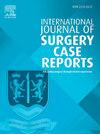Gastrointestinal stromal tumor in patient with neurofibromatosis type 1: A case report
IF 0.6
Q4 SURGERY
引用次数: 0
Abstract
Introduction
Neurofibromatosis type 1 (NF1) is an autosomal dominant disorder with a 5–15 % risk of gastrointestinal stromal tumors (GISTs), of which 20–30 % may be malignant. Standard treatment includes surgery and adjuvant imatinib for high-risk cases. This case presents a rare large GIST in NF1 without organ invasion.
Presentation of case
A 39-year-old male with NF1 presented with a 6-month history of progressive abdominal distension and intermittent pain. Examination revealed typical NF1 signs, including café-au-lait spots, neurofibromas, and Lisch nodules. Imaging showed a large proximal ileal mass, suggestive of GIST. Surgery confirmed a well-circumscribed tumor, and histology revealed high-risk spindle-cell GIST with positive CD117 and DOG1 staining. The patient started adjuvant imatinib therapy for 3 years. Six months postoperatively, he remained asymptomatic with no recurrence on imaging. Regular follow-ups with CT scans and blood tests were scheduled to monitor disease progression and treatment response.
Discussion
NF1 is an autosomal dominant disorder with an increased risk of developing GISTs, which occur earlier and are more aggressive than sporadic cases. GIST diagnosis relies on imaging, with CT and MRI providing essential details, and confirmation through histopathology with CD117 and DOG1 markers. Surgical resection remains the primary treatment, with adjuvant imatinib recommended for high-risk cases to reduce recurrence. NF1-related GISTs have higher recurrence rates but respond well to targeted therapy. Regular follow-up with imaging is crucial.
Conclusion
Although GISTs are rare in NF1, they pose a significant risk due to their potential for malignancy and recurrence.
求助全文
约1分钟内获得全文
求助全文
来源期刊
CiteScore
1.10
自引率
0.00%
发文量
1116
审稿时长
46 days

 求助内容:
求助内容: 应助结果提醒方式:
应助结果提醒方式:


